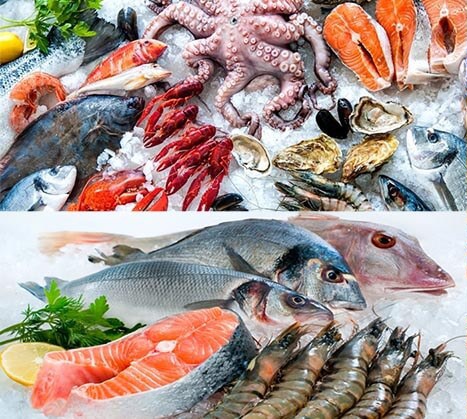No products in the cart.
Introduction:
Selecting fresh seafood can be a delightful experience, offering the promise of a delicious meal full of flavor and nutrition. However, with so many options available, it’s essential to know how to choose the best quality seafood to enjoy its full potential. Here are some valuable tips to help you select fresh and delicious seafood.
- Trust Your Senses: When choosing seafood, trust your senses. Fresh seafood should have a clean, ocean-like smell, reminiscent of the sea breeze. Avoid seafood with a strong, fishy odor, as it may indicate that the seafood is not fresh.
- Check the Eyes: For whole fish, look at the eyes. They should be clear and bright, not cloudy or sunken. Cloudy or opaque eyes are a sign that the fish is not fresh. Additionally, the eyes should be slightly bulging, indicating freshness.
- Inspect the Skin: The skin of seafood should be shiny and vibrant, with a slight sheen. Avoid seafood with dull or discolored skin, as it may indicate deterioration. For shellfish, such as shrimp and prawns, the shells should be firm and intact.
- Examine the Flesh: Press the flesh of the seafood gently with your finger. It should be firm and bounce back when pressed. Avoid seafood with soft or mushy flesh, as it may be past its prime.
- Check for Odors: Fresh seafood should have a mild, briny scent reminiscent of the ocean. Avoid seafood with strong, ammonia-like odors, as it may be spoiled. Additionally, avoid seafood with an overpowering “fishy” smell.
- Ask Questions: Don’t hesitate to ask your fishmonger or seafood vendor questions about the seafood’s freshness, origin, and handling practices. A knowledgeable vendor will be happy to provide you with information to help you make an informed decision.
- Consider Seasonality: Pay attention to the seasonality of seafood. Certain types of seafood are more abundant and flavorful during specific seasons. Opt for seasonal varieties for the best quality and taste.
- Look for Local Options: Whenever possible, choose locally sourced seafood. Local seafood is often fresher, as it spends less time in transit. Additionally, supporting local fishermen and businesses helps sustain the local economy and promotes sustainability.
- Keep Temperature in Mind: Ensure that the seafood is properly chilled or stored on ice to maintain freshness. Avoid seafood that has been left at room temperature for an extended period, as it may spoil quickly.
Conclusion:
By following these tips, you can confidently select fresh and delicious seafood for your next culinary adventure. Whether you’re preparing a simple seafood pasta dish or a gourmet seafood feast, choosing high-quality seafood will elevate your cooking and delight your taste buds. Enjoy the bounty of the sea with fresh and flavorful seafood!

